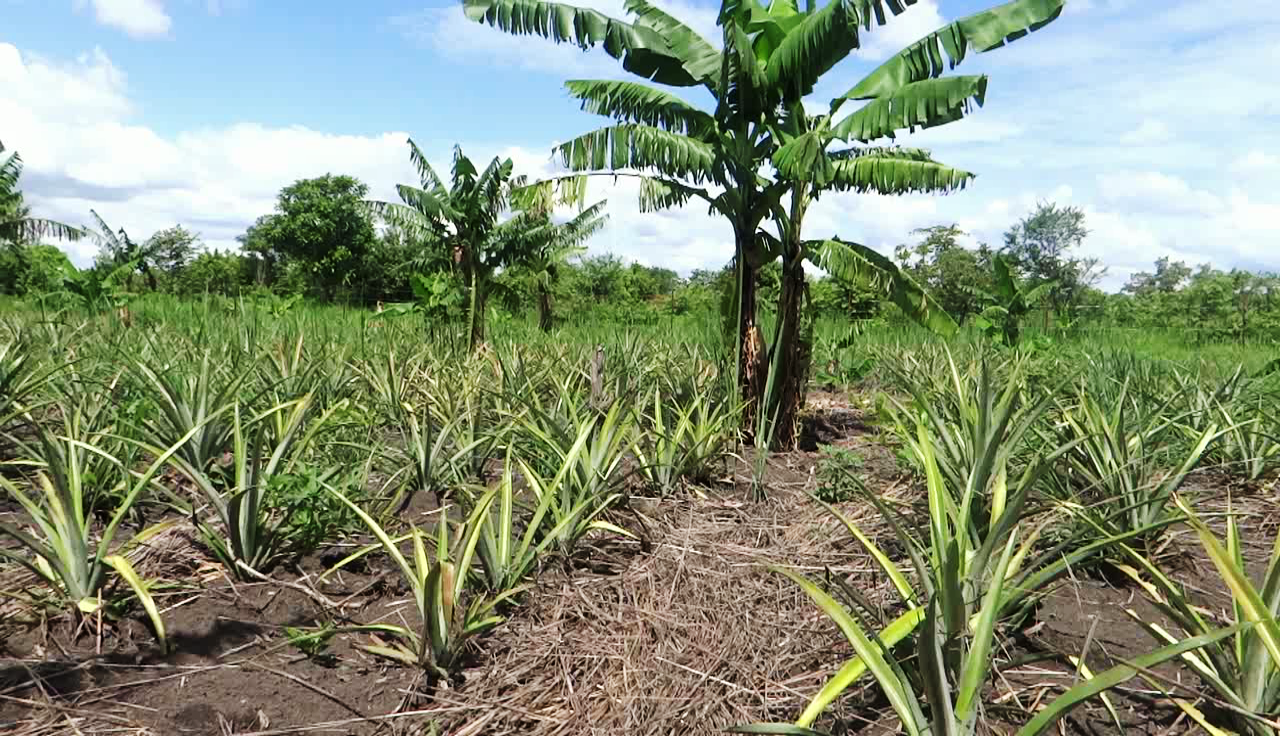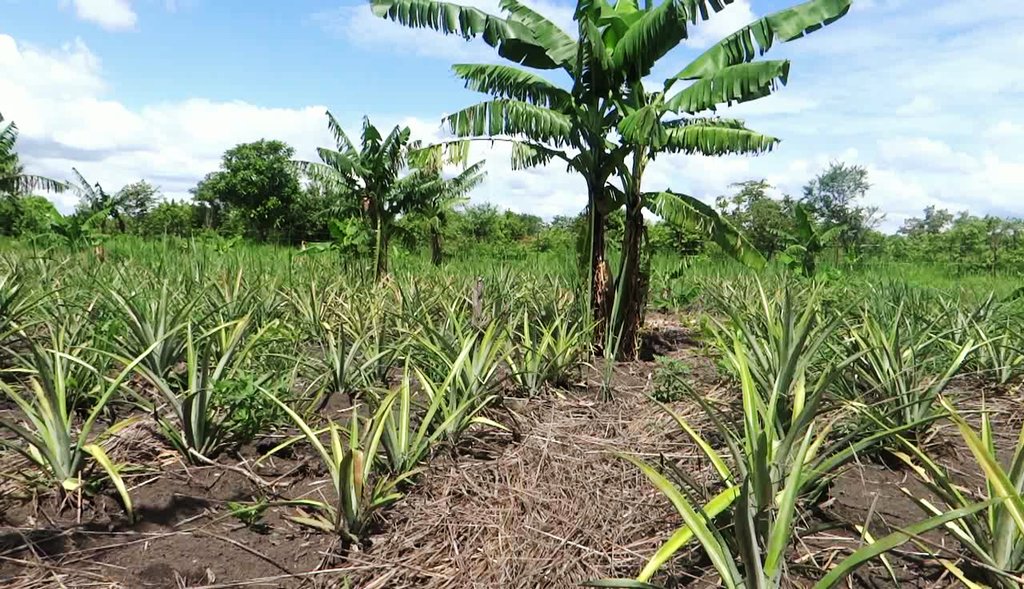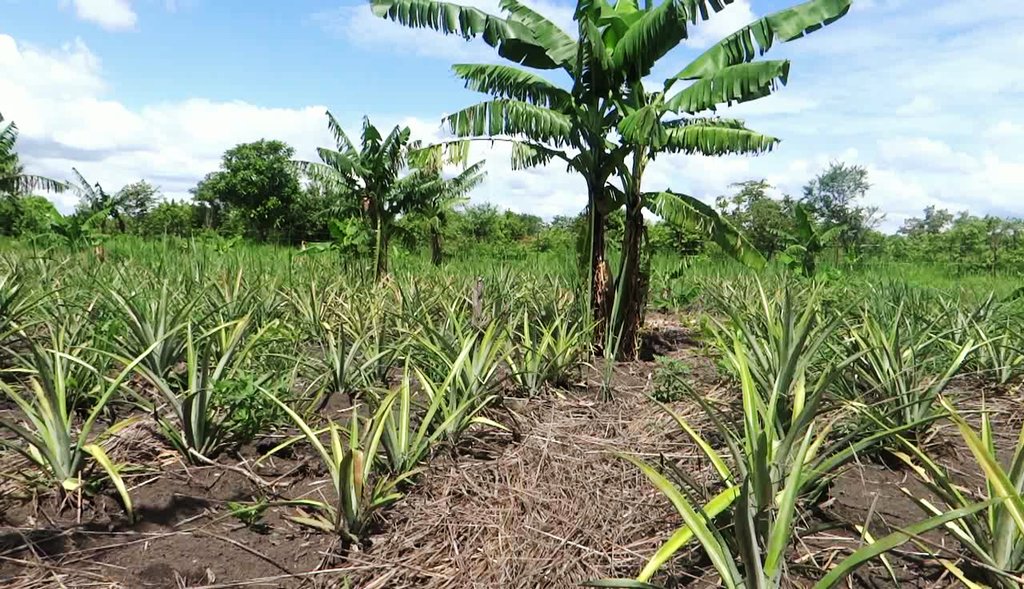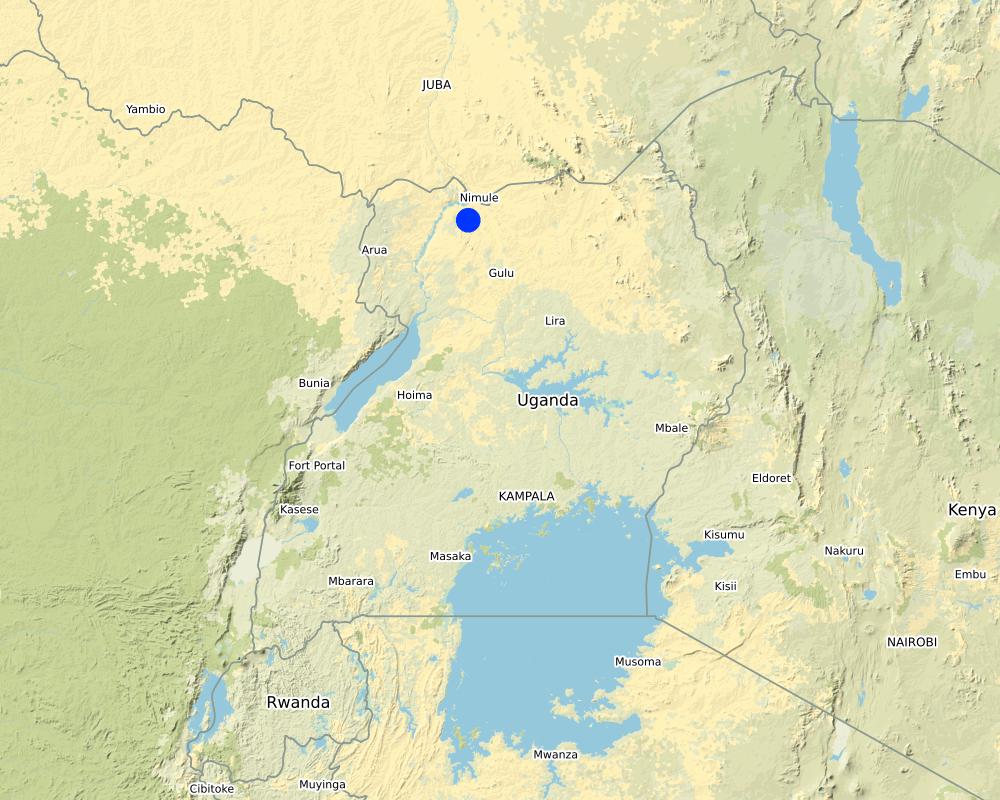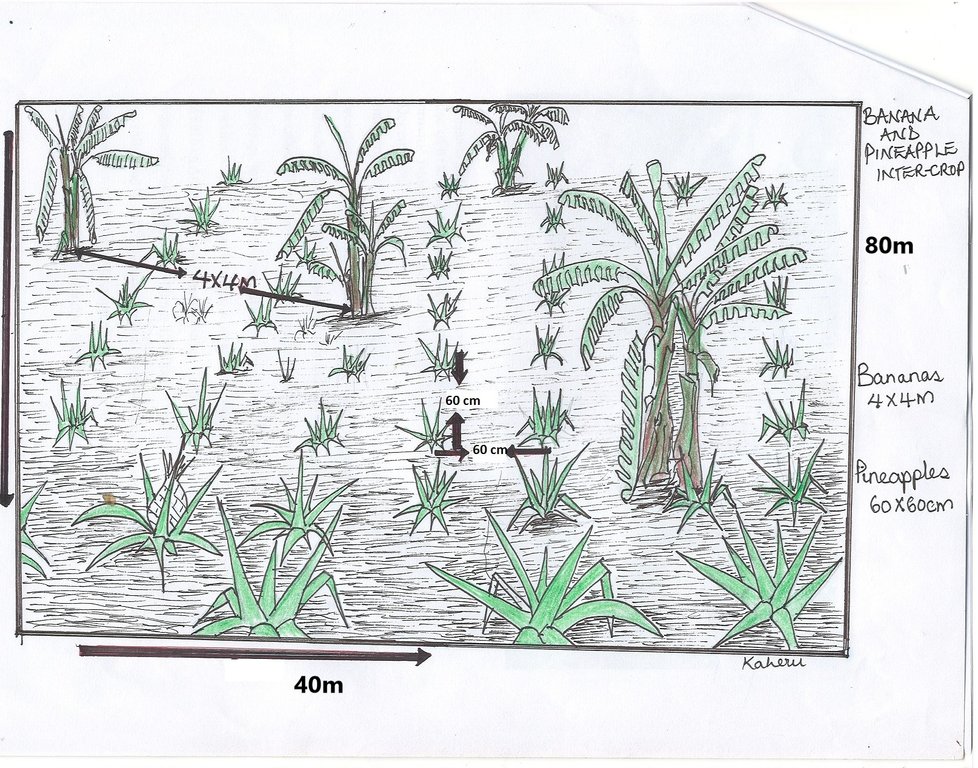Intercropping Bananas and Pineapple for Optimal Land Utilisation [Uganda]
- Creation:
- Update:
- Compiler: Jalia Namakula
- Editor: –
- Reviewers: Drake Mubiru, Udo Höggel
Ori Onda le onda rii
technologies_2317 - Uganda
View sections
Expand all Collapse all1. General information
1.2 Contact details of resource persons and institutions involved in the assessment and documentation of the Technology
Key resource person(s)
land user:
Ecima Pascal
0779747476
Anzoa Mixed Farm
Adjumani District
Uganda
Name of project which facilitated the documentation/ evaluation of the Technology (if relevant)
Scaling-up SLM practices by smallholder farmers (IFAD)Name of the institution(s) which facilitated the documentation/ evaluation of the Technology (if relevant)
Uganda Landcare Network (ULN) - Uganda1.3 Conditions regarding the use of data documented through WOCAT
When were the data compiled (in the field)?
10/05/2017
The compiler and key resource person(s) accept the conditions regarding the use of data documented through WOCAT:
Yes
1.4 Declaration on sustainability of the described Technology
Is the Technology described here problematic with regard to land degradation, so that it cannot be declared a sustainable land management technology?
No
2. Description of the SLM Technology
2.1 Short description of the Technology
Definition of the Technology:
A banana (musa acuminata) and pineapple (ananas comosus) inter-cropping system focusses on optimal land utilization and efficient use of available resources for small holder farmers. This is a good practice for controlling long term soil loss in agro-ecosystems. It involves less crop- and soil management practices as compared to annual intercropping systems.
2.2 Detailed description of the Technology
Description:
Intercropping is the practice of growing two or more crops in close proximity. Traditional growing of many annual crops like soybean, groundnut, beans and vegetables like tomatoes and onions as intercrop in banana plantations increased the risk of soil erosion in the agricultural land of Uganda. These crops require more cultural farming practices that enhance the removal of top soil layer. Therefore, the intercropping system of banana with pineapple is practiced for optimum land utilization and control of soil loss. As these crops are perennial, they require less soil and crop management practices as compared to annual crops.
The banana pineapple intercrop pattern was established with the aim of making effective use of available resources, optimum land utilisation, and sustainable production. The technology was established in 2016. The area experiences a bimodal rainfall pattern with annual rainfall ranging between 700mm-1200mm. The farm lies on 0.32 ha of land located in the valley and from observations the soils on this farm could be classified as clay loams. The bananas grown are a local Musa spp. Bananas are planted at a spacing of 4 m×4 m from row to row and plant to plant and are taken as the major crop in this technology. The pineapples are an improved variety (smooth cayenne) which is yellow cylindrical and juicy, planted at a spacing of 60 cm × 60 cm inter and intra row and planted at a distance of 75cm from a banana plant.
Establishment activities for the banana plantation were bush clearing, ploughing, excavation of 60cm×60cm planting holes, animal manure application (obtained from the owner’s farm) mixed with top soil and used to fill half the planting holes and, lastly planting the banana suckers. After a year the farmer introduced pineapples which, involved digging planting holes, the application of animal manure and the planting of pineapple suckers. Planting of bananas took 2 man days whereas planting of pineapples took 4 man days. Maintenance activities included regular spraying of pineapples with pesticide and fungicides, pruning, desuckering and thinning of bananas, weeding and watering.
According to the farmer, inter-cropping bananas with high value crops such as pineapples increases his income while ensuring food security. It reduces his vulnerability to climate change since the pineapples act as soil cover and therefore increase soil moisture retention. “With this technology we reduce management costs since we do not need to weed, spray, apply manure on 2 separate gardens” he says. In addition inter-cropping minimizes risks associated with growing a single crop and ensures stable subsistence food availability and possible income. It also promotes the effective use of available resources, increased crop productivity and soil erosion control.
The disadvantages of the technology include:
- Increased competition for water and nutrients
- Weeding in banana pineapple inter crops becomes challenging since pineapples have a prickly leaf
- During establishment of the bananas and pineapples plantations trees are cut down to create space for the crops and this leads to deforestation
- Pineapples habour pests and diseases that may cause damage to bananas
- This intercrop requires a high level of skills from the farmer
2.3 Photos of the Technology
2.4 Videos of the Technology
Comments, short description:
Video showing the banana pineapple intercrop captured in Anzoa village, Adjumani District, Northern Uganda
Date:
10/05/2017
Location:
Anzoa village, Adjumani District
Name of videographer:
Jalia Namakula
2.5 Country/ region/ locations where the Technology has been applied and which are covered by this assessment
Country:
Uganda
Region/ State/ Province:
Northern Uganda
Further specification of location:
Anzoa Adjumani District
Comments:
Geo reference 3.34850 and 31.93278. Captured in Adjumani District Northern Uganda
Map
×2.6 Date of implementation
Indicate year of implementation:
2016
2.7 Introduction of the Technology
- Farmer to Farmer adoption
Comments (type of project, etc.):
The land user got knowledge on establishment and management of the inter-cropping system from a fellow farmer in Luwero District Central Uganda
3. Classification of the SLM Technology
3.1 Main purpose(s) of the Technology
- improve production
- reduce, prevent, restore land degradation
- adapt to climate change/ extremes and its impacts
- create beneficial economic impact
3.2 Current land use type(s) where the Technology is applied

Cropland
- Perennial (non-woody) cropping
Main crops (cash and food crops):
Banana, pineapple
If land use has changed due to the implementation of the Technology, indicate land use before implementation of the Technology:
The area was originally a private woodlot which was cut to establish this enterprise
3.3 Further information about land use
Water supply for the land on which the Technology is applied:
- mixed rainfed-irrigated
Comments:
During the dry season the farm depends on pumped water from a stream (River Adiidi) which flows through it
Number of growing seasons per year:
- 1
Specify:
Pineapples and bananas are a perenial crops. However the banana is harvested once annually whereas the pineaple is harvested twice annually
3.4 SLM group to which the Technology belongs
- improved ground/ vegetation cover
- integrated soil fertility management
- improved plant varieties/ animal breeds
3.5 Spread of the Technology
Specify the spread of the Technology:
- evenly spread over an area
If the Technology is evenly spread over an area, indicate approximate area covered:
- < 0.1 km2 (10 ha)
3.6 SLM measures comprising the Technology

agronomic measures
- A1: Vegetation/ soil cover
- A2: Organic matter/ soil fertility
Comments:
Pineapples act as a soil cover because it spreads out
3.7 Main types of land degradation addressed by the Technology

soil erosion by water
- Wt: loss of topsoil/ surface erosion

soil erosion by wind
- Et: loss of topsoil

chemical soil deterioration
- Cn: fertility decline and reduced organic matter content (not caused by erosion)
Comments:
The pineapples once well established act as a soil cover enhancing moisture retention, reduction of soil erosion and increase of soil fertility in the field when the leaves decompose
3.8 Prevention, reduction, or restoration of land degradation
Specify the goal of the Technology with regard to land degradation:
- prevent land degradation
Comments:
The pineapples cover the soils hence prevent soil erosion
4. Technical specifications, implementation activities, inputs, and costs
4.1 Technical drawing of the Technology
4.2 Technical specifications/ explanations of technical drawing
The banana-pineapple inter-crop lies on a 0.32ha land size with 300 suckers of local banana variety bought from Kasese District Western Uganda and planted at a spacing of 4m×4m . The size of the banana planting hole was 60× 60 cm.
Some of the pineapple planting material (500 suckers) was sourced from the Operation Wealth Creation (OWC) a government programme and the other planting material (7500) was bought from Luweero District and planted at a spacing of 60× 60 cm within the banana plantation. The pineapple variety grown is 'Smooth Cayenne'.
4.3 General information regarding the calculation of inputs and costs
Specify how costs and inputs were calculated:
- per Technology area
Indicate size and area unit:
3200 square meter
other/ national currency (specify):
UGX
Indicate exchange rate from USD to local currency (if relevant): 1 USD =:
3650.0
Indicate average wage cost of hired labour per day:
6600
4.4 Establishment activities
| Activity | Type of measure | Timing | |
|---|---|---|---|
| 1. | Bush Clearing | Management | August 2016 |
| 2. | Excavating planting holes for bananas | Management | August 2016 |
| 3. | Application of manure | Agronomic | September 2016 |
| 4. | Acquisition of planting material | Management | September 2016 |
| 5. | Planting | Agronomic | November 2016 |
4.5 Costs and inputs needed for establishment
If possible, break down the costs of establishment according to the following table, specifying inputs and costs per input. If you are unable to break down the costs, give an estimation of the total costs of establishing the Technology:
-1.0
| Specify input | Unit | Quantity | Costs per Unit | Total costs per input | % of costs borne by land users | |
|---|---|---|---|---|---|---|
| Labour | Bush clearing | people | 14.0 | 6600.0 | 92400.0 | 100.0 |
| Labour | Excavating planting holes | hole | 100.0 | 1000.0 | 100000.0 | 100.0 |
| Labour | Application of manure | basket | 100.0 | 500.0 | 50000.0 | 100.0 |
| Labour | Planting | plant | 100.0 | 200.0 | 20000.0 | 100.0 |
| Equipment | Water pump | piece | 1.0 | 50000.0 | 50000.0 | 100.0 |
| Equipment | Pangas | piece | 3.0 | 10000.0 | 30000.0 | 100.0 |
| Equipment | Hoes | piece | 3.0 | 10000.0 | 30000.0 | 100.0 |
| Equipment | Hose pipes | Roll | 1.0 | 100000.0 | 100000.0 | 100.0 |
| Equipment | Jerricans | pc | 4.0 | 7000.0 | 28000.0 | 100.0 |
| Plant material | Banana suckers | piece | 300.0 | 1500.0 | 450000.0 | 100.0 |
| Plant material | Pineapple suckers | piece | 8000.0 | |||
| Fertilizers and biocides | Animal manure | bgs | 20.0 | 15000.0 | 300000.0 | 100.0 |
| Total costs for establishment of the Technology | 1250400.0 | |||||
If land user bore less than 100% of costs, indicate who covered the remaining costs:
500 pineapple suckers were given to the farmer by the OWC. The remaining 7500 suckers were received from Luweero District, Central Uganda.
Comments:
The farmer bought the banana suckers from Kasese District
4.6 Maintenance/ recurrent activities
| Activity | Type of measure | Timing/ frequency | |
|---|---|---|---|
| 1. | Weeding | Agronomic | twice a week in dry season |
| 2. | Watering | Agronomic | thrice a year |
| 3. | Spraying with pesticides | Agronomic | once a fortnight |
4.7 Costs and inputs needed for maintenance/ recurrent activities (per year)
| Specify input | Unit | Quantity | Costs per Unit | Total costs per input | % of costs borne by land users | |
|---|---|---|---|---|---|---|
| Labour | weeding | pp | 3.0 | 6600.0 | 19800.0 | 100.0 |
| Labour | watering | pp | 3.0 | 6600.0 | 19800.0 | 100.0 |
| Labour | spraying | knapsack | 3.0 | 3000.0 | 9000.0 | 100.0 |
| Fertilizers and biocides | Pesticides | liters | 6.0 | 20000.0 | 120000.0 | |
| Total costs for maintenance of the Technology | 168600.0 | |||||
4.8 Most important factors affecting the costs
Describe the most determinate factors affecting the costs:
Peoples attitudes (people fear weeding in pineapples because they are prickly and pineapples habour snakes), labour scarcity
5. Natural and human environment
5.1 Climate
Annual rainfall
- < 250 mm
- 251-500 mm
- 501-750 mm
- 751-1,000 mm
- 1,001-1,500 mm
- 1,501-2,000 mm
- 2,001-3,000 mm
- 3,001-4,000 mm
- > 4,000 mm
Specify average annual rainfall (if known), in mm:
1200.00
Specifications/ comments on rainfall:
The rainfall onset for the first season came late (early April instead of March)
Agro-climatic zone
- humid
5.2 Topography
Slopes on average:
- flat (0-2%)
- gentle (3-5%)
- moderate (6-10%)
- rolling (11-15%)
- hilly (16-30%)
- steep (31-60%)
- very steep (>60%)
Landforms:
- plateau/plains
- ridges
- mountain slopes
- hill slopes
- footslopes
- valley floors
Altitudinal zone:
- 0-100 m a.s.l.
- 101-500 m a.s.l.
- 501-1,000 m a.s.l.
- 1,001-1,500 m a.s.l.
- 1,501-2,000 m a.s.l.
- 2,001-2,500 m a.s.l.
- 2,501-3,000 m a.s.l.
- 3,001-4,000 m a.s.l.
- > 4,000 m a.s.l.
Indicate if the Technology is specifically applied in:
- not relevant
5.3 Soils
Soil depth on average:
- very shallow (0-20 cm)
- shallow (21-50 cm)
- moderately deep (51-80 cm)
- deep (81-120 cm)
- very deep (> 120 cm)
Soil texture (topsoil):
- medium (loamy, silty)
Soil texture (> 20 cm below surface):
- fine/ heavy (clay)
5.4 Water availability and quality
Ground water table:
< 5 m
Availability of surface water:
good
Water quality (untreated):
good drinking water
Is water salinity a problem?
No
Is flooding of the area occurring?
No
5.5 Biodiversity
Species diversity:
- medium
Habitat diversity:
- high
Comments and further specifications on biodiversity:
Biodiversity is medium on farm but the surrounding area is a woodlot with a diversity of organisms
5.6 Characteristics of land users applying the Technology
Sedentary or nomadic:
- Sedentary
Market orientation of production system:
- mixed (subsistence/ commercial
Off-farm income:
- 10-50% of all income
Relative level of wealth:
- rich
Individuals or groups:
- individual/ household
Level of mechanization:
- mechanized/ motorized
Gender:
- men
Age of land users:
- middle-aged
Indicate other relevant characteristics of the land users:
The owner of the farm is a medical doctor
5.7 Average area of land owned or leased by land users applying the Technology
- < 0.5 ha
- 0.5-1 ha
- 1-2 ha
- 2-5 ha
- 5-15 ha
- 15-50 ha
- 50-100 ha
- 100-500 ha
- 500-1,000 ha
- 1,000-10,000 ha
- > 10,000 ha
Is this considered small-, medium- or large-scale (referring to local context)?
- large-scale
Comments:
Average land holding here is 5 acres
5.8 Land ownership, land use rights, and water use rights
Land ownership:
- individual, titled
Land use rights:
- individual
Water use rights:
- communal (organized)
Comments:
For this land, the farmer owns a land title. However because it is close to a river, other members are allowed to use the river water resources
5.9 Access to services and infrastructure
health:
- poor
- moderate
- good
education:
- poor
- moderate
- good
technical assistance:
- poor
- moderate
- good
employment (e.g. off-farm):
- poor
- moderate
- good
markets:
- poor
- moderate
- good
energy:
- poor
- moderate
- good
roads and transport:
- poor
- moderate
- good
drinking water and sanitation:
- poor
- moderate
- good
financial services:
- poor
- moderate
- good
6. Impacts and concluding statements
6.1 On-site impacts the Technology has shown
Socio-economic impacts
Production
crop quality
Comments/ specify:
Application of manure on pineapples benefits the bananas. Since the intercrop was establish more bigger bunches of bananas are harvested, though records were not available
risk of production failure
Comments/ specify:
Pineapples act as a soil cover for the bananas hence reducing their vulnerability to droughts, thereby reducing on risk of crop failure
Income and costs
diversity of income sources
Comments/ specify:
is yet to harvest
workload
Comments/ specify:
Workload reduces since weeding pineapples means weeding bananas too
Ecological impacts
Soil
soil moisture
Comments/ specify:
The pineapple intercrop acts as a soil cover therefore increasing soil moisture retention
soil cover
Comments/ specify:
pineapples act as soil cover
6.3 Exposure and sensitivity of the Technology to gradual climate change and climate-related extremes/ disasters (as perceived by land users)
Gradual climate change
Gradual climate change
| Season | Type of climatic change/ extreme | How does the Technology cope with it? | |
|---|---|---|---|
| annual temperature | increase | well | |
| annual rainfall | decrease | well |
6.4 Cost-benefit analysis
How do the benefits compare with the establishment costs (from land users’ perspective)?
Short-term returns:
slightly positive
How do the benefits compare with the maintenance/ recurrent costs (from land users' perspective)?
Short-term returns:
slightly positive
Comments:
The land user, at this point in time, has not yet started harvesting the pineapples. He, however has started harvesting the bananas and their yield has slightly increased.
6.5 Adoption of the Technology
- single cases/ experimental
Comments:
The land user adopted the technology from another region. Adjumani is an area with relatively longer drought periods, so far he is the only farmer practicing this technology.
6.6 Adaptation
Has the Technology been modified recently to adapt to changing conditions?
No
6.7 Strengths/ advantages/ opportunities of the Technology
| Strengths/ advantages/ opportunities in the land user’s view |
|---|
| Income diversity |
| Weeds are suppressed |
| Optimal utilisation of land |
| Strengths/ advantages/ opportunities in the compiler’s or other key resource person’s view |
|---|
| Moisture retention |
| Reduction of total crop failure risk |
| Maximisation of resource utilisation |
6.8 Weaknesses/ disadvantages/ risks of the Technology and ways of overcoming them
| Weaknesses/ disadvantages/ risks in the land user’s view | How can they be overcome? |
|---|---|
| Weeding is challenging | Hire labour |
| The pineapples have prickly leaves | Put on overalls while weeding |
| As pineapples grow they close the spacing in between making field maintenance difficult | Use chemical control for weeds |
| Weaknesses/ disadvantages/ risks in the compiler’s or other key resource person’s view | How can they be overcome? |
|---|---|
| Competition for water and nutrients is enhanced | Apply animal manure |
| Inter-crops habour pests that are harmful | Spraying using herbicides and regular crop checks for effective mangement |
| The bananas may provide a lot of shade for the pineapples thereby reducing their productivity | Make the banana spacing a little wider |
7. References and links
7.1 Methods/ sources of information
- field visits, field surveys
1 person
- interviews with land users
1 person
7.2 References to available publications
Title, author, year, ISBN:
Intercropping and its application to banana production in East Africa, Ouma, 2009
Available from where? Costs?
https://www.researchgate.net/publication/228488472_Intercropping_and_its_application_to_banana_production_in_East_Africa_A_review
Links and modules
Expand all Collapse allLinks
No links
Modules
No modules


